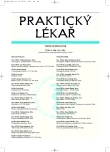Oral anticoagulant therapy
Perorální antikoagulační léčba kumariny
Perorální antikoagulancia jsou používána primární a sekundární prevenci žilních i tepenných trombóz. V České republice je převážně užíván kumarinový derivát warfarin. Jeho komplexní mechanismus účinku a farmakologické vlastnosti vyžadují monitoraci léčby pomocí protrombinového času udávaného indexem INR. Ani správně vedená léčba kumariny zcela nezaručuje úplné odstranění rizika krvácení či recidivy trombotické příhody. Chybný postup však tato rizika výrazně zvyšuje. Délka antikoagulační léčby se odvíjí od typu a lokalizace trombózy, je nutno zohlednit, zda se jedná o první příhodu nebo recidivu a zvážit přítomnost rizikových faktorů, včetně trombofilie.
Klíčová slova:
warfarin, tromboembolická nemoc, protrombinový čas, INR, lékové interakce
Authors:
A. Hluší
Authors‘ workplace:
Fakultní nemocnice Olomouc
; Přednosta: Prof. MUDr. Karel Indrák, DrSc.
; Hemato-onkologická klinika
Published in:
Prakt. Lék. 2006; 86(9): 531-534
Category:
Therapy
Overview
Oral anticoagulants are used in the primary and secondary prophylaxis of venous and arterial thrombosis. Warfarin, a coumarin glycoside, has been widely used in the Czech Republic. Its complex mechanism of action and pharmacological properties require regular prothrombin time evaluation using an International Normalized Ratio (INR) index. Even the correct management of warfarin therapy does not guarantee elimination of bleeding risk or thrombotic recurrence. But these risks increase with wrong practice. The length of anticoagulant therapy depends on the type and location of thrombosis. It is also important to establish whether it is the first incident or a recurrence of thrombosis and to consider other risk factors including thrombophilia.
Key words:
warfarin, tromboembolic disease, prothrombin time, INR, drug interactions
Labels
General practitioner for children and adolescents General practitioner for adultsArticle was published in
General Practitioner

2006 Issue 9
- Metamizole vs. Tramadol in Postoperative Analgesia
- Metamizole at a Glance and in Practice – Effective Non-Opioid Analgesic for All Ages
- Memantine in Dementia Therapy – Current Findings and Possible Future Applications
- Advances in the Treatment of Myasthenia Gravis on the Horizon
- Hope Awakens with Early Diagnosis of Parkinson's Disease Based on Skin Odor
Most read in this issue
- Tandem Heart used for treatment of the most severe forms of heart failure – left ventricular support
- Oral anticoagulant therapy
- Epiglotitis – The Experience with patients hospitalized in RES FN Motol
- Non-setroidal anti-inflammatory drugs – use in treatment of cardiovascular disease an cardiovascular risks
